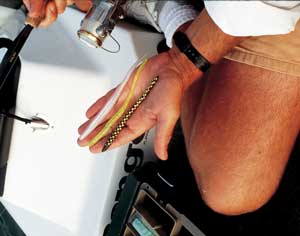
It probably won’t come as a big surprise to the serious bass fishermen who read this magazine, but I’m not a real fan of the month of April.
As someone who really loves to fish a crankbait, I sometimes feel a little lost.
There’ll be some bass you can catch with a lipless crankbait, or some fish you’ll catch with a small crankbait, but for the most part, April is a month when soft baits really outperform hard baits.
At least partly, it’s because bass across much of North Carolina are really keying in on the spawn. If you go anywhere in the state in April, some bass will be spawning somewhere. And the ones that aren’t will be up shallow, thinking about it.
So there’s not much going on out there at that ledge that drops from 7 to 10 feet into the creek channel.
If you don’t like to fish for spawning bass — or if you don’t have much success doing it — you can still find a few prespawn fish. That may mean going to some of our more northern reservoirs where the spawn is a little later. By that, I mean driving from Lake Wylie to Buggs Island. The spawn will be a couple of weeks later at Buggs Island.
There’s always been an argument about where in a lake bass will spawn the earliest: upper or lower end? I have an idea, but it’s based on the fact that I know the first fish that come off the bed, the ones I like to catch ganged up at little corners and secondary points on into May, you find those fish first on the lower end of almost all lakes.
So, if you can go up into the upper end of a lake — you’re fishing in the river, most of the time — you’ll find some prespawn fish. You can catch ’em on lipless crankbaits or a flat-sided crankbait, such as a Rapala DT Flat 3.
Some of my best days on the water were at Buggs Island in the spring when the water was up and I could swim a worm around the bushes. But now, with fishing pressure growing the way it has over the past few years, a lot of times those fish aren’t as aggressive as they once were.
Now, there are times when you’ve got to be able to make a cast way back to the base of a bush — and that can be pretty hard to do, especially for a weekend fisherman. But no one is going to argue that you can catch fish if you can pitch or flip a soft-plastic bait tight to the cover.
I think a good arsenal for most fishermen in April would include a Zoom Trick worm or a couple of tube baits, probably a Fluke and a Senko. Those baits will catch spawning fish.
I usually struggle in April because I’m not as proficient sight-fishing for bass as other things I do. Really, the best thing for me is to fish a lake with slightly-stained water where the guys who are really good sight fishermen can’t see them either.
When I find myself in that situation, I go to a little deal I call a “mojo rig.” And, no, that’s not the great big bucktail “mojo plugs” striper fishermen troll off the Outer Banks in the winter.
A mojo rig is a little finesse rig for bedding fish you can’t see. It’s fairly simple: I thread a small bullet weight, usually about 3/16-ounce, and tie on a small barrel swivel. Then, I use about 1 foot of light line for a leader. The business end is a Zoom Trick Worm rigged weedless, with the point of the hook turned back into the body of the worm.
It’s a pretty good tactic to catch fish because you can cast to and fish targets because of the short leader. How I use it is to locate the kind of shallow cover that fish will usually be close to when they spawn. That might be a rock in one lake or a stump in another, just typical spawning cover. You really don’t want to see the fish because you don’t want them to see you.
I’ll cast to a spot, let the rig sink down there, and after the weight settles to the bottom, that little worm will be in the fish’s bed. If and when she picks it up, it’s easy to see your line jump and move, and you’ve got time to set the hook.
You don’t fish your usual Trick Worm colors, the bubble gums and whites. I like to use something like green pumpkin or watermelon, a more natural color because I really don’t have to see the fish to pick up the worm to know I’m getting a bite.
If I’m still having trouble getting bites or if the fish seem real finicky about picking the worm up and carrying it very far, I’ll downsize and go to a Zoom finesse worm, using the same colors and the same rig.
It’s not the most fun way to fish for me, but I have to admit, it’s effective, and it’s one of the ways that someone who is an average fisherman can have a good day without having to flip a tube in a bed and wait 10 minutes for a fish you can see to pick it up.
Editor’s note: David Fritts is a 49-year-old professional bass fisherman from Lexington. He was the 1993 BASS Masters Classic champion, the 1993-94 BASS Angler of the Year and the 1997 FLW Tour Champion. His sponsors include: Bass Pro Shops, Evinrude Motors, Ranger Boats, Chevy Trucks, Minn-Kota trolling motors, American Rodsmith, Rapala crankbaits and fishing line, Zoom plastics, Solar Bat sun glasses, Mountain Dew, Gripper (ECS Anchor Supply), VMC hooks, Pro Pocket and Blue Fox.




Be the first to comment